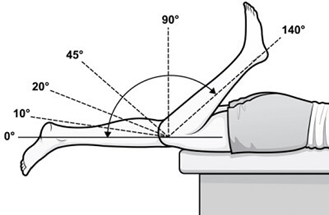Unlike what many people think, ACL tears are not only limited to contact sports such as soccer. According to Renstron et al., we have about 85% of ACL tears that happen in a non-contact sudden change of direction or sudden deceleration.
ACL tears are also common in women compared to men. The high prevalence in women is contributed by factors such as muscle imbalances, anatomy, and hormones.
Can I Run Again After an ACL Injury?
Yes, you can run again after an ACL tear.
However, resuming running after an ACL-reconstruction surgery is both a physical and a mental issue. It is a significant step to returning to active sporting activities.
How Long After ACL Surgery Can You Run
Usually, a return to running should happen after 12 weeks or four months after knee surgery. However, return to running after an ACL surgery calls for several requirements.
Some of these include:
- Your knee should have minimal or no swelling
- You must be in a position to walk without limping
- Your knee must be able to bend and straighten fully
- You must do lunges and squats before jogging
- You should have negligible or nor knee pain at all
- You must be in a position to walk for 20 minutes without feeling any pain
- You must have done some workouts aimed at strengthening your non-operated knee
Proper rehabilitation is critical in returning to full activity after ACL reconstruction surgery. Your first stage of recovery should focus on improving quad power and restoring your knee range of motion.
Allow the new ACL injury to heal during this time. You will require a physical therapist to help you know which workouts to engage in and how to progress to strengthening exercises.
Here is a general recovery timeline after an ACL reconstruction:
- Begin a walk or jog program three months (12 weeks) after surgery
- Move on to agility and running after 4 ½ to 6 months (16-24 weeks)
- You can return to sports like running earliest at eight months after surgery, although 10-12 months is the common timeframe
The surgeon’s advice is that you use a knee brace as you return to sports as it helps to prevent the risk of re-injury. With this, you will have added stability even as your knee gets used to the increased sports activity.
The recovery timeframe differs from patient to patient according to surgeons. After treatment, total recovery time is based on factors such as:
- Strength
- Your body’s ability to heal faster after treatment
- Your body’s response to therapy
- Your compliance to a home exercise program
Working with a PT and an MD helps significantly to ensure you return to your normal sports activity safely.
The table below shows the criteria suggested by the large 2018 review to resume sports training.
| Clinical | Strength | Performance |
| – Pain below 2/10 on the VAS scale – No effusion or swelling – Have a full knee extension – Your limb symmetry in knee flexion range of motion should be at 95% | – Quadriceps LSI>70% – Hamstring limb symmetry index >70% | – Step-up test or single-leg squat without an increase in knee valgus – Hoop test LSI >70% |
According to Mick Hughes, the Melbourne ACL Rehabilitation Guide co-author and a physiotherapist, you should also have a >85% LSI for the following workouts.
- 30-second side bridge
- 20 single-leg hamstring bridges
- 45 seconds single-leg balanced on the affected leg
- 5 single-leg squats off a 20cm box
- 20 single-leg heel raises
- 10 single-leg rises from 90 degrees knee bend
Most clinicians and therapists are no longer relying on time-based criteria for a return to running. Many therapists have turned to performance criteria for decision-making since it has proven to be more objective.
Returning to Sports and Surgery After ACL Surgery
Returning to normal exercise and sports after ACL surgery can turn out to be a long process.
As stated earlier, the rehab process could take between 5-6 months of physical therapy. You will need to work hand in hand with your therapist to ensure total restoration of your knee range of motion. You will also have to work towards lowering the extremity strength.
This rehabilitation protocol for ACL reconstruction involves multiple phases of working through. You must complete the checklist for each stage before moving on to the next.
Here are the phases you will need to go through:
Phase 1: Improving Your Movement
For an effective rehab after ACL reconstruction, this stage should start 3-4 days after having your ACL surgery.
This phase aims at helping your leg to ease back into regular movement and motion. Failure to start this stage fast enough may cause your joint and tissues to become stiff quickly.
Waiting for longer to start your rehabilitation also means that you will have much ground to cover when you begin. Specialist advice would then be that you start this physical therapy as soon as it is possible.
In this phase, the first thing is to deal with the post-operative swelling. This process aims at getting rid of post-surgical pain from the injury. Moreover, it ensures that you have greater knee mobility and increases muscle capacity around the knee joint.
This procedure also places you in a better position to effectively work your way up to the next tasks of your rehab.
Before you can move to restore the full range of motion in your knee, you should be able to fully flex your knee and extend it. This knee flexibility is critical towards the restoration of natural knee movement.

A full range of motion for your knee is essential in the restoration of control and activation of various leg muscles and ligaments. In particular, you will require full knee extension to contract your quadriceps muscles. This ensures that you regain your quadriceps muscle power and provides strength to your knee for walking.
This first stage also trains you to start walking again using the proper mechanics that will not strain your ACL injuries.
By the end of this stage, your knee should be capable of full extension. This extension is critical for a patient, especially when carrying out many daily chores.
Some of the activities that will require full knee extension include putting on your socks or shoes, walking up and downstairs, walking, among others. A flexible knee will also prepare you for the next stage, which involves strengthening workouts.
Phase 2: Restoring Your Strength and Control
Mostly, the second stage starts around 4-6 weeks after surgery. Technically, however, this phase begins after the completion of the first phase.
This stage helps you to increase power and balance on your operated leg. The stage targets that you regain between 80-90% strength of your healthy leg.
Strength restoration is critical for you to progress to impact sports such as running and jumping. These sports activities require that your muscles be strong enough to handle the loading forces that come with such exercises.
Re-strengthening of the hip muscles, ligament, knees, and ankles is critical to avoid re-injuries, especially in cases where your ACL injury undergoes extra strain.
This phase involves a program of workouts that involve steady workout progressions for the patient. Here, you transition from partial squatting to full squatting. With time, you should also be in a position to perform single-leg exercises, which include step-ups and lunges.
The one-leg exercise is a challenge for you to control your leg position. In the process, you end up achieving what we call alignment control. Alignment control prevents your leg from rotating or collapsing inward towards your midline.
The other importance of this second phase is that it helps to improve your proprioception. Proprioception is a process that enables you to have an awareness of your body’s movement and position.
Your body and your brain will need to be in constant communication to help ensure there is balance and stability. This process is crucial since a sport such as running involves shifting the balance from one leg to the other.
For athletes, the body also requires to adjust its stability in a matter of hundredths to tenths of a second. This is essential in producing the power athletes need for propelling themselves forward.
Failure to use your leg muscles for stabilizing your body exerts extra pressure on all your ligaments. As such, this will risk the healing process of ACL injuries.
Typically, some of the tasks that you will do in this phase include balancing on one leg. You can also try to stand on an unstable pad with closed eyes, which is a more complex task for many patients.
In summary, phase two helps ensure that your surgery leg is strong and stable before you move on to more training.
Phase 3: Relearning Proper Force Absorption
Typically, the third phase should start somewhere between a timeline of 12-16 weeks after surgery.
At this stage, your surgery leg can properly handle ballistic activities. Also, it is in this phase that a patient can slowly return to running.
The main focus of this third phase is to teach your muscles to absorb impact as you run. Weak muscles may not be able to absorb the force of impact effectively. This underlines why the previous two phases are critical for patients.
This phase also continues to better your strength and proprioception. At this stage, the focus is mainly to ensure that the surgery leg gets back to an equal level of strength as the other leg of the patient.
Your leg needs to be able to sustain the constant loading force exerted by the ballistic sports activities.
The first activity in this phase is usually practicing landing a small jump on your two legs. Progress into repeated jumps as you land on both legs.
Next, patients practice landing a small jump on one leg safely, then practice repeatedly hopping on one leg.
The essence of these jumps is to prepare your leg for the series of small jumps that are involved in a sport such as running. These workouts will help you to assess whether your leg is ready to sustain the stress of the repeated jumps.
Once you can comfortably have full control of your leg in both hoping and landing, it’s a sign that you are ready to run again.
Conclusion
An ACL surgery should not kill your running career. With the right rehabilitation, you can get back fully to run.
Ensure you get a specialist who will walk you through the rehabilitation criteria. Also, ensure you religiously fulfill all the requirements for each of the rehabilitation phases because they are crucial for your return to running.
With that done, nothing will stop you from getting back on the track.



Join the conversation